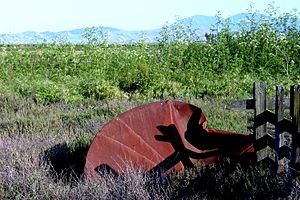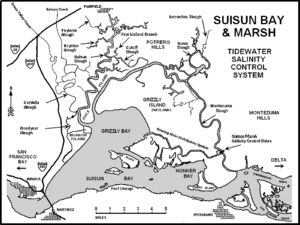Suisun Marsh facts for kids
The Suisun Marsh (pronounced soo-SOON) is located in northern California. It's known as the largest brackish water marsh on the west coast of the United States. A marsh is a type of wetland, like a swamp, but with more grasses and reeds. This marsh is part of the San Francisco Bay tidal estuary, which means it's where fresh river water mixes with salty ocean water, and the water level changes with the tides.
The Suisun Marsh is a home for many birds and other wildlife. It's formed where the Sacramento and San Joaquin rivers meet, along with water from smaller local streams. It's right next to Suisun Bay and is part of the larger San Francisco Bay estuary system. The marsh gets its name from the Suisunes, a Native American tribe who lived in this area about 200 years ago.
Contents
What is Suisun Marsh?
The Suisun Marsh covers a huge area of 116,000 acres (about 470 square kilometers) of land, bays, and waterways called sloughs. It's one of the biggest estuarine marshes in the western United States.
Over thousands of years, the marsh was formed by sediment (tiny bits of rock and soil) carried by the Sacramento and San Joaquin Rivers from the Sierra Nevada and Vaca Mountains. This sediment settled in the San Francisco Bay area, creating the marsh's unique patchwork look. The marshy areas have peat soils, which are made from decayed plants over a long time.
History of the Marsh
Originally, Suisun Marsh was a huge area of wetlands that flooded and drained with the tides. In winter, many migratory waterfowl (birds that fly south for winter) used the ponds. From the 1850s (during the California Gold Rush) until about 1880, people called market hunters used the marsh to hunt waterfowl for food and feathers to sell in San Francisco.
However, from the 1880s to the 1930s, much of the marsh was changed into farmland. Farmers built levees and dikes to hold back the water. But over time, the soil became too salty, making it hard to grow crops or even graze cattle. So, farming stopped in the wetland areas.
Most of the marsh was then bought by public and private groups to protect it as a habitat for waterfowl, mainly for hunting. Later, large water projects in the Sacramento-San Joaquin watersheds changed how salty the marsh water was, making it even saltier. To protect the wetlands, landowners worked to pass laws to keep the area from being developed with houses or businesses. They also worked to reduce the impact of the water projects on the marsh's salt levels.
Today, Suisun Marsh is home to many different fish, wildlife, and plants. You can find many river otters, native fish, and birds like marsh wrens and American white pelicans.
Rush Ranch and Education
Rush Ranch is a 2,070-acre (8.4 square kilometer) part of Suisun Marsh that is a preserved tidal marsh. It was bought in 1988 to protect wildlife and allow public access. It's now managed by the Solano Land Trust, a group that protects farmland and open spaces.
A special part of Rush Ranch is the Rush Ranch Educational Council (RREC). This group of volunteers offers a free educational program for 3rd and 4th graders on field trips. The program teaches children about the Patwin Indians, who were the original people living at the ranch. They learn about Patwin culture and daily life at a recreated Patwin village on the ranch. Volunteers show how the Patwins used tools and materials to live off the land in a sustainable way.
Grizzly Island Wildlife Area
Another public area in the marsh is the Grizzly Island Wildlife Area. This area is mainly managed for waterfowl, but over 230 types of birds have been seen here, along with many mammals, amphibians, reptiles, and fish. Grizzly Island has a lot of river otters, which you might see swimming in the waterways. In the fall, the tule elk herd at Grizzly Island breeds, and you can hear the male elk bugling (making loud calls) in the mornings and evenings. Some parts of the Wildlife Area have limited access during hunting seasons.
The levees (raised banks) in the marsh also help keep salty water from getting into the fresh drinking water used by 22 million people from the Delta.
How Water is Managed in the Marsh
The levees in Suisun Marsh were first built by farmers in the 1800s to create farmland. While similar systems still work in other areas, they failed in Suisun Marsh because the soil became too salty. So, parts of the marsh were changed from farms back into wetlands that are flooded all year or just part of the year.
Today, about 230 miles of levees help maintain these wetlands. From mid-October to mid-January, managed wetlands are flooded with 8 to 12 inches of water to attract waterfowl for hunting.
The rest of the year, the ponds are flooded and drained on a special schedule. This helps grow plants that waterfowl like to eat, such as alkali bulrush, fat hen, and brass buttons. Ponds that stay flooded through the spring provide places for young birds to grow up. This flood-and-drain cycle also helps wash out salts from the soil. This water management also supports plants like tules, cattails, saltgrass, and pickleweed. These plants might not be food for waterfowl, but they provide homes for small creatures that are important food for birds before they breed.
When the Suisun farmlands became wetlands again, they created new homes for waterfowl. This also helped reduce damage to crops in the Central Valley caused by waterfowl. By about 1930, waterfowl hunting became the main use of the Suisun Marsh. It's still the main use today, with 158 private duck clubs and large public hunting areas.
Keeping the Water Just Right
People who manage the wetlands for both private hunting clubs and public land get water from the many sloughs in the marsh. Montezuma Slough is one of the largest. It's open at both ends, and the incoming tide (flood tide) is stronger and lasts longer than the outgoing tide (ebb tide). This causes water to flow from west to east, bringing saltier water from Grizzly Bay further into the marsh.
The flood tide takes longer to travel through Montezuma Slough than it does through the main Suisun Bay channel. This means that high tide at the east end of the slough happens at a different time than in the main channel. So, instead of being pushed back, the water in the slough keeps flowing eastward, bringing in more salty water.
To control the salt levels, the California State Water Project and the federal Central Valley Project built the Montezuma Slough Salinity Control Gates. These gates started working in 1989. They are located across Montezuma Slough and are used from October to May. They block the salty incoming tide from Grizzly Bay but allow the freshwater outgoing tide from the Sacramento-San Joaquin Delta to pass through. These gates have worked better than expected, so other planned salt control projects were not needed.
Fish in the Marsh
Even though Suisun Marsh is managed for waterfowl, it's also a very important home for fish, especially wild salmon. There are monitoring stations throughout the marsh that check how water management affects fish populations. Fish screens are also used to stop fish from being trapped in the waterfowl ponds.
The marsh helps support 80% of California's commercial salmon fishing industry. It provides important areas for young salmon to grow, allowing them to grow twice as fast as those in the upper parts of the rivers. This greatly increases their chances of survival. The marsh is also an important area for native fish like the delta smelt, which is a federally protected endangered species.
Special Plants of Suisun Marsh
Suisun Marsh is home to the only two known places where the Suisun thistle grows. This plant, called Cirsium hydrophilum var. hydrophilum, is a type of thistle that is a federally listed endangered species. The Suisun thistle is a perennial plant, meaning it lives for more than two years. It stays in its young stages until it's ready to flower. Once the plant's base (rosette) reaches its full size, it can take a year or more for the leafy stem to grow and flower.






